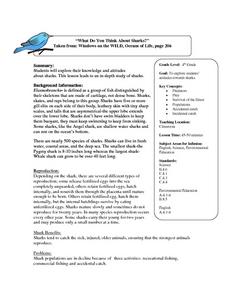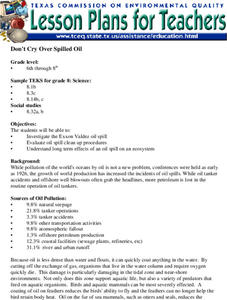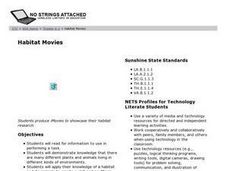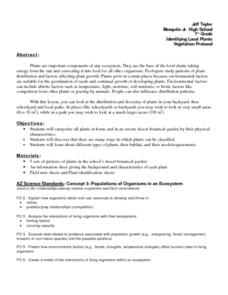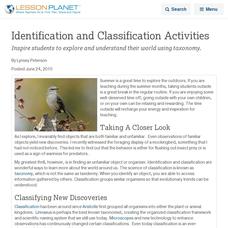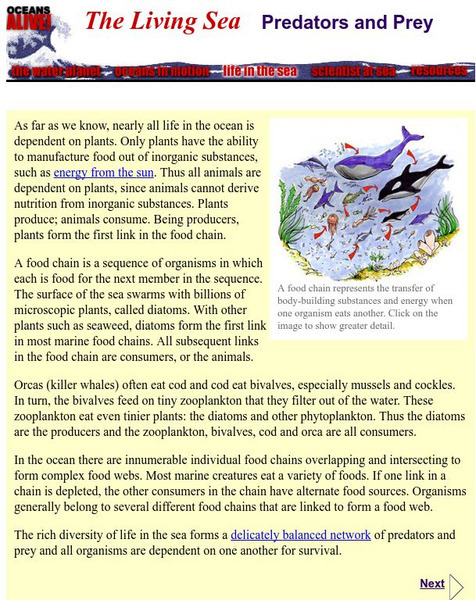Curated OER
What Do You Think About Sharks?
Fourth graders explore sharks. They read a story about sharks and act out using Reader's Theater. They discuss fact and attitude statements about sharks and complete a Shark Survey. They create a shark promotion brochure informing...
Curated OER
Creating a Freshwater Ecosystem
Students correctly identify some fishes of Texas and parts of their ecosystem.
Curated OER
Don't Cry Over Spilled Oil
Middle schoolers study the Exxon Valdez Oil Spill while evaluating oil spill clean up activities. They discover the long term impact can have on an ecosystem by completing this experiment.
Curated OER
I Will Survive!
The students will be given approximately five minutes to individually brainstorm general plant and animals adaptations that they already know about. The class will use these as a starting point to develop a KWL chart specific to desert...
Curated OER
Primate Characteristics and Exaptation
High schoolers compare the features of gorilla to humans. For this biology lesson, students simulate adaptation using materials found in the classroom. They explain what exaptation means.
Curated OER
Venom!
Students examine the nature of venom. They conduct an experiment to demonstrate how proteins such as venoms can be denatured using raw eggs, beakers, heated water, and compresses.
Curated OER
Munching Insects
Students design an experiment to discover what types of plants particular insects prefer. They comprehend that insects eat only specific plants and that this has particular implications for noxious weeds. Students observe and collect...
Curated OER
Animals Spiral Puzzle
In this animal puzzle worksheet, students use a set of 8 clues about animals to complete a spiral puzzle. A reference web site is included for additional activities.
Curated OER
Australian Animal Fact Finding Mission
In this Australian fact finding worksheet, students answer a set of 8 questions about an Australian animal they are researching.
Curated OER
Habitat Movies
Students create movies of various habitats and animals using their knowledge of the subject and the computer program iMovie. Emphasis is placed on cooperative learning and research.
Curated OER
Create a Habitat for an Animal
For this marine life worksheet, students label the ocean animal and each part of its habitat. Students then draw one of the habitats including the animals and plants that live there.
Curated OER
Food Webs
Fourth graders discover how organisms depend upon each other in an ecosystem. In this ecosystems instructional activity, 4th graders use food webs to discuss the interdependence between organisms in an ecosystem.
Curated OER
Animal Adaptations
Animal adaptations, such as camouflage, are high-interest topics that are easily integrated into both reading and math curriculum.
Aiken County Public Schools
Claymation in the Classroom
Students design an appropriate and usable storyboard and then create a claymation video. They take digital photographs frame by frame, then assemble the stop-motion movie using video software.
Curated OER
U.S. History: Antebellum Heroes and Villains
Eighth graders research and write reports on key figures of the Antebellum Period. The projects also include pictures, bibliographies, and timelines about their assigned figure. In addition, 8th graders present oral reports to classmates.
Curated OER
Unit Plan Template
Learners research the adaptations of desert animals and build their research skills. In this the adaptations of desert animals lesson plan, students describe major factors that desert animals have on their habitat. Learners...
Curated OER
My Colorful Food Chain
Students explore biology by participating in a dietary habit activity. In this food chain lesson, students discuss their own diets and the animals we feed upon daily. Students create a poster demonstrating the animals that we feed upon...
Curated OER
Identification and Classification Activities
Explore and understand your world with taxonomy.
Curated OER
What is an Animal Group?
Pupils discover that people live in groups and animals live in groups or alone. They list ways that families cooperate and work together as a group. They create a large dinosaur made out of geometric shapes.
Museum of Science
Museum of Science: The Living Sea: Predators and Prey
This Museum of Science page does an excellent job of explaining the importance of plants as producers in the sea. The food chain or food web has to start with the plants.
Science Buddies
Science Buddies: Predators and Prey: How Do Cats Respond to Bird Sound
A science fair project that ask whether cats respond to familiar bird sounds more readily that bird sounds in general. The Science Buddies project ideas are set up consistently beginning with an abstract, objective, and introduction,...
Science Buddies
Science Buddies: Now You See It, Now You Don't! Test Your Peripheral Vision
The survival of our ancient ancestors depended on their ability to use peripheral vision to find prey and to avoid predators. Almost everything we do-from riding a bike, to dribbling a basketball, to reading a book-depends on peripheral...
CK-12 Foundation
Ck 12: Life Science: 12.8 Predation
Understand the predator-prey relationship in an ecosystem.
Science Buddies
Science Buddies: M&m Survival Challenge
In the wild, there are two types of animals: the hunters and the hunted. A good predator is always on the prowl for fresh prey. What can an animal do to stay off of the menu? Find out how some animals use camouflage, and why sometimes it...
